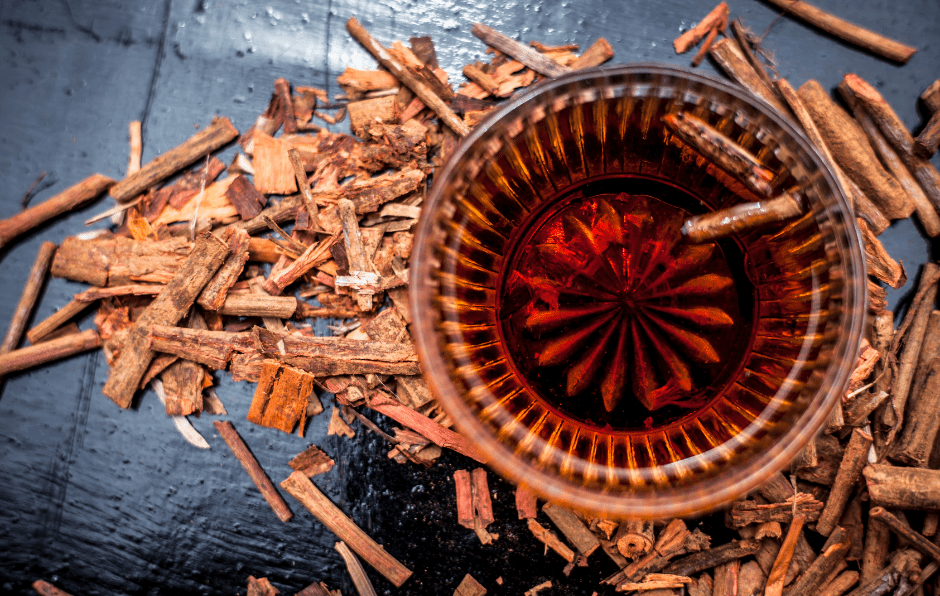Want to colour your soap naturally? If you love burgundy soaps, then this is the recipe for you!
The natural colourant we are using for this recipe is madder root powder. Madder root can create a range of colours from pinks to reds and purples!
What is Madder Root Powder?
Madder root is a perennial herbaceous climbing plant that is native to Northern Africa, Western Asia and Europe. The madder root powder is 100% natural with a rich, deep red hue and is derived from the roots of the madder plant.
It is a natural dye frequently used in soap making and textile dyeing, particularly for coloring fabrics such as wool and cotton.

Why Use Madder Root Powder in Soap Making?
When used in soap making, natural madder root powder can create soap bars in shades of pink, red, or burgundy.
It can be added either to the lye water or at trace during the soap making process. In this recipe, we have added the powder to the lye water to create a stunning dark burgundy colour!
For a pink to red hue, a recommended usage rate is 12 to 18 grams (2 to 3 teaspoons) of madder root powder per pound of soap.
Let's have a go at our madder root soap recipe...
This soap recipe makes 9-10 bars of soap
Equipment:
To make our madder root soap recipe, you will need:
- Gloves
- Goggles
- Digital scales
- Digital thermometer
- Stick blender
- Soap mould or DIY alternative
- Silicone spatula
- Microwave safe bowl
- Plastic measuring cup, ideally 2x 1L and 1x 2L
Ingredients
- Coconut oil 280g
- Kokum butter 120g
- Castor oil 40g
- Olive oil 360g
- Water 240g
- Sodium hydroxide/ Lye 114.91g
- Madder root powder 15g
- Roman chamomile oil 8g | 9ml
- Bergamot oil 8g | 9ml
- Lavender oil 8g | 9ml

1. Mix the sodium hydroxide solution
- Put on your gloves and goggles.
- Open a window, the fumes are unpleasant.
- Weigh the water.
- In a separate bowl, weigh the sodium hydroxide and madder root powder.
- Add the sodium hydroxide and madder root powder to the water not the other way around.
- Mix well until combined.
- Leave to cool, it will be very hot.

2. Weigh and melt the oils
- Weigh the oil into a heatproof bowl.
- Melt over a pan of boiling water, or using short bursts in the microwave.
- Stir regularly.
- Once melted, leave to cool.
- In a separate jug, weigh and mix your essential oils.

3. Test the temperatures
- Test the temperature of the sodium hydroxide solution. It should be between 25C and 40C.
- Leave it to cool if necessary, but don't reheat it if it's too cool.
- Test the temperature of the oil mixture. It should be between 35C and 40C.
- Leave it to cool or reheat if necessary.
- Once the temperatures are correct, add the sodium hydroxide solution to the oil mixture.

4. Blend until trace
- Stir with the hand blender, and blend with short pulses.
- Watch for the soap batter starting to thicken.
- Test for trace by dripping soap batter on the surface of the mixture. If the drips sit on the surface before disappearing, your mixture has reached trace.
- Stop blending once your soap has reached trace.
- Add the essential oils.
- Mix and blend a little until combined.

5. Pour into moulds
- Pour your soap moulds. We also provide a range of shaped silicone soap moulds!
- Tap on the work surface to get rid of air bubbles.
- Insulate with towels.
- Leave on a flat surface for 48 hours

6. Leave to cure
- Unmould your soap.
- Place bars with a space in between.
- Leave to cure for 4-6 weeks
Continue Reading
Now you know how to use madder root to dye your soap, why not continue reading?
- Interested in more natural ways to dye your soap? Take a look at our nettle soap recipe!
- Love making your own skincare? Check out our new niacinamide serum recipe!
- Want to try melt and pour soap making? Read our beginners guide to melt and pour soap making!
How did you find this madder root soap recipe? Let us know how you got on in the comments!



